What is an Electric Circuit? Types of Circuits and Network
What is an Electric Circuit? Types of Circuits and Network
Electric Circuit, Network, Complex Circuits and other Types of Circuits
What is an Electric Circuit?
An electric circuit is a closed loop network which provides a return path for the flow of current. Or a closed conducting path in which current can flow is called a circuit. An electric circuit is also known as electrical network or electrical circuit.
An electrical circuit is the combination of different active and passive components such as resistors, capacitors, inductors, diodes, transistors etc. which form an electrical network. In a closed-loop circuit, the electric current flows from the source (such as battery) in the conducting material (e.g. wires and cables) to the load (i.e. light bulb) and hence returns back to the source.
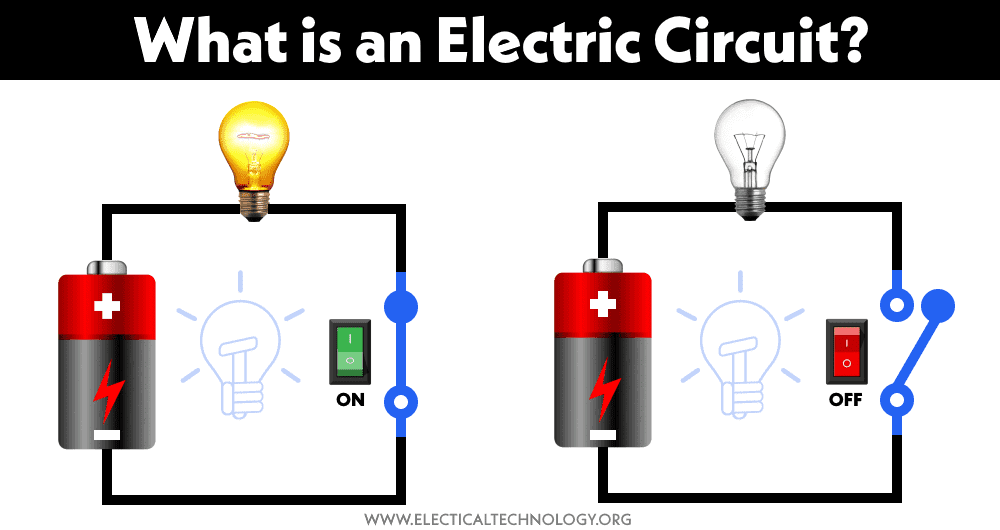
What is Electronic Circuits?
Electronic Circuit is a type of electric circuit consisting of many electronic components such as diodes, transistors, resistors, capacitors etc. where at least one of active components must be presented in the circuit which further differentiate it from the electrical circuit. This way, it is known as an electronic circuit instead of an electrical circuit.
What is an Electrical Network?
A combination of different electric elements and components which are connected in any way (simple or complex configuration) is called an electric network. It is the same term used for an electric circuit but most commonly associated with the complex networks which are solved by network theorems.
Complex Networks
A circuit which contains many electrical elements such as resistors, capacitors, inductors, current and voltage sources (both AC and DC) where all the circuit components and elements are complexly configured is called a complex network. These kinds of networks can’t be solved easily by simple Ohm’s Law or Kirchhoff’s laws. If so, the number of equations will be noticeable more.
The easiest way to solve and analyze a complex network is using specific techniques such as network theorems i.e. Norton’s theorem, Thevenin’s theorem, Superposition theorem, star – delta transformation, Supernode and supermesh circuit analysis etc.
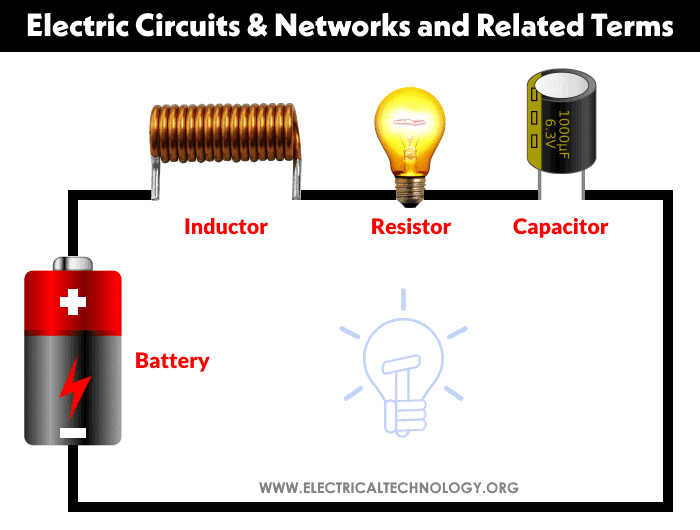
Types of Electric Circuits
There are many types of electrical circuits such as:
-
Open Circuit
-
Closed Circuit
-
Short Circuit
-
Series Circuit
-
Parallel Circuit
-
Series-Parallel Circuit
-
Star-Delta Circuit
-
AC Circuit
-
DC Circuit
-
Single-Phase Circuit
-
Three-Phase Circuit
-
Resistive Circuit
-
Inductive Circuit
-
Capacitive Circuit
-
Resistive, Inductive (RL Circuit)
-
Resistive, Capacitive (RC Circuit)
-
Capacitive, Inductive (LC Circuits)
-
Resistive, Inductive, Capacitive (RLC Circuit)
-
Linear Circuit
-
Non Linear Circuit
-
Unilateral Circuits
-
Bi-lateral Circuits
-
Active Circuit
-
Passive Circuit
We will briefly discuss one by one as follows.
Open Circuit
A circuit which has no return path for current to flow in it (i.e. which is not completed) is known as an open circuit. In other words, a circuit where voltage tends to the EMF (of generating source) and no current is flowing at all is called an open circuit.
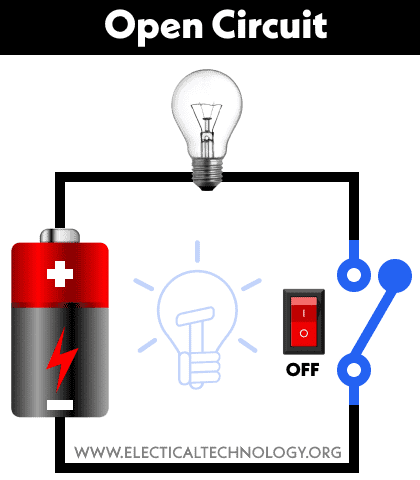
Example of an open circuit: A circuit with an open switch or blown fuse where the light bulb connected to the battery. So the bulb won’t glow as the circuit is not completed i.e. it is an open circuit and there is no flowing current in it.
Closed Circuit
A circuit which has a return path for current to flow in it (i.e. completed circuit) is known as closed circuit.
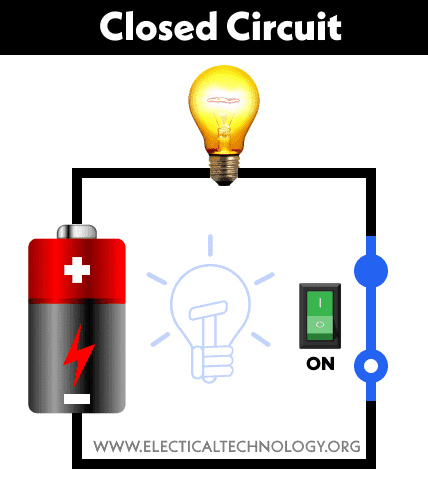
Example of a short circuit: A circuit with a close switch where the light bulb connected to the battery. So the bulb glows as current is flowing in the filament of the bulb due to the completed circuit.
Short Circuit
A circuit which has a return path for current to flow in it where the value of resistance = zero. (i.e. completed or closed circuit without connected load) is known as short circuit. In other words, A circuit where voltage tends to zero and current tends to infinity is called a short circuit.
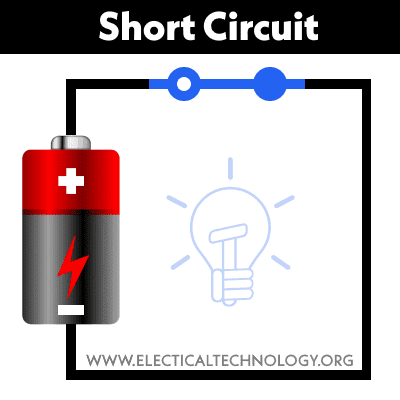
Example of a short circuit: A circuit with a close switch without load connected to the supply voltage. In other words, when a Phase or Line wire touches the Neutral wire without a load between them. In that case, the fuse will blow or the circuit breaker will trip. In absence of proper protection, the short circuit may damage the appliance or cause a very serious injury.
Series Circuit
In this circuits, all the electrical elements (Voltage or Current sources, inductors, capacitors, resistors etc) are connected in series i.e. There is only one path for traveling electricity e.g. these are single branch circuits.
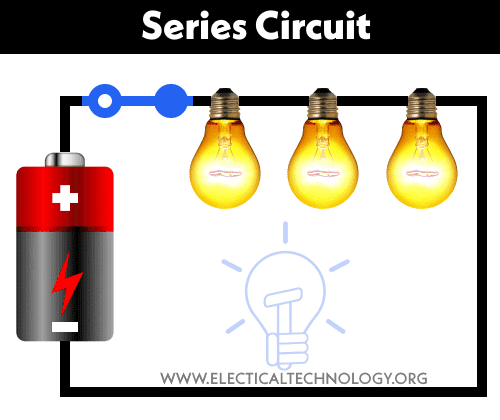
Parallel Circuit
In this circuits, all the electrical elements (Voltage and Current sources, inductors, capacitors, resistors etc) are connected in parallel i.e. There are many paths for traveling electricity and the minimum branches in this circuit are two.

Series-Parallel Circuit
If circuit elements are series connected in some parts and parallel in others, that would be a series-parallel circuit. In other words, this is a combination of series, parallel and series-parallel circuits.
Following are more derived circuits of the Series, parallel, and Series-parallel circuits
-
Pure Resistive Circuit
-
Pure Inductive Circuit
-
Pure Capacitive Circuit
-
Resistive, Inductive Circuit i.e. RL Circuit
-
Resistive, Capacitive Circuit i.e. RC Circuit
-
Capacitive, Inductive Circuits i.e. LC Circuits
-
Resistive, Inductive, Capacitive Circuit i.e. RLC Circuit
-
Series & Parallel of R, L & C Circuits
-
Combination of Series-Parallel Circuit i.e. Complex Circuit
These all circuits are shown in fig below.
Click image to enlarge
In the given circuits, all the above-mentioned components or elements may be connected in series, parallel, or in both combinations of series-parallel configuration.
Related Posts:
Star-Delta Circuit
These kinds of circuits are connected in Star connection or delta connection. In these circuits, electrical elements are connected in a way that is undefined in terms of series, parallel or series-parallel configuration. Star delta circuits can be solved by Star to Delta and Delta to Star transformation.

Before analyzing an electric circuit and network, you must know the following useful terms associated with electric circuits which specify the nature and characteristics of a circuit.
AC Circuit
A circuit containing an AC supply source of voltage is known as AC circuits. The supply sources for example are alternator and synchronous generators.
DC Circuit
A circuit containing a DC supply source of voltage is known as DC circuits. The supply sources for example are batteries and DC generators.
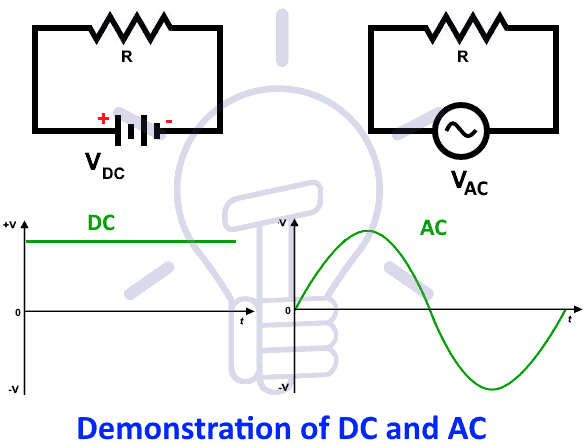
Single Phase Circuits
The AC power where all the voltages have the same sinusoidal pattern at a specific time period is known as single phase AC supply. In single phase AC circuits, only two wires (known as phase or line and Neutral) are needed to complete the circuit.
Polyphase Circuits
Poly means more than one. As the name suggests, the AC power where there are three sinusoidal voltages having 120° phase difference. In three phase AC circuits, three phase three wires or three phase four wires are needed to complete the circuit.
- Related Post: Different between Single Phase and Three Phase Supply
Circuit’s Parameters, Constants and Related Terms
Different components or elements which are used in electric circuits are called circuit’s parameters or constants i.e. resistance, capacitance, inductance, frequency etc. These parameters can be lumped or distributed.
Active Circuit
A circuit which contains on one or more EMF (Electromotive force) sources is called Active Circuit
Passive Circuit
A circuit, in which no one EMF source exist is called Passive Circuit
Linear & Non Linear Circuits
Linear Circuit
A linear circuit is an electric circuit in which circuit parameters (resistance, inductance, capacitance, waveform, frequency etc) are constant. In other words, a circuit whose parameters are not changed with respect to current and voltage is called a linear circuit.
Non Linear Circuit
A nonlinear circuit is an electric circuit whose parameters are varied with respect to current and voltage. In other words, an electric circuit in which circuit parameters (resistance, inductance, capacitance, waveform, frequency etc) are not constant, is called a Non-linear circuit.
-
Related Post: The Main Difference between Linear and Nonlinear Circuit
Unilateral & Bi-lateral Circuits
Unilateral Circuits
In unilateral circuits, the property of circuit changes with the change of direction of supply voltage or current. In other words, a unilateral circuit allows the current to flow only in one direction. Diode or rectifier is an example of a unilateral circuit because it does not perform the rectification in both directions of supply.
Bi-lateral Circuits
In bilateral circuits, the property of circuit does not change with the change of direction of supply voltage or current. In other words, a bilateral circuit allows the current to flow in both directions. Transmission line is the best example of a bilateral circuit because, providing the supply voltage from any direction (starting end or finishing end), the circuit properties remain constant.
Related Terms to Electric Circuits and Networks
Node
A point or junction where two or more circuit’s elements (resistor, capacitor, inductor etc) meet is called Node
Branch
A part or section of a circuit which is located between two junctions is called a branch. In a branch, one or more elements having two terminals can be connected.
Loop
A closed path in a circuit where more than two meshes can occur is called loop i.e. there may be many meshes in a loop, but a mesh does not contain one loop.
Mesh
A closed loop which contains no other loop within it or a path which does not contain other paths is called Mesh.
Good to know:
We use different theorems to solve complex networks. Generally, Complex networks can be solved by the following two methods.
-
Direct method
-
Equivalent Circuit Method
We will discuss these methods one by one in our next post with details.
Related Posts:
URL Copied















![Toni Kroos là ai? [ sự thật về tiểu sử đầy đủ Toni Kroos ]](https://evbn.org/wp-content/uploads/New-Project-6635-1671934592.jpg)


